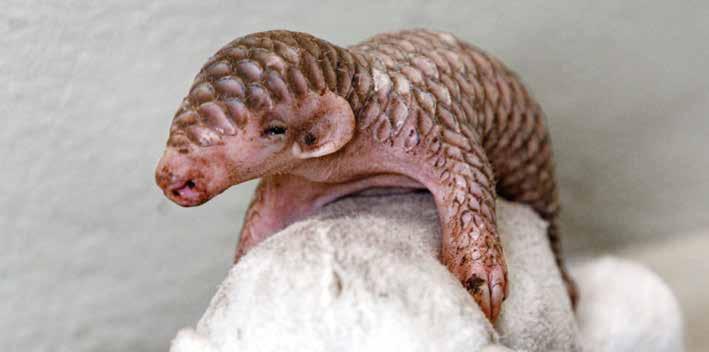
4 minute read
COMMON HEALTH PROBLEMS
• Dry skin is easily treated by increasing healthy fats in the animals' diet (fish oils and flaxseed oils) and malacetic conditioner skin spray can calm this ailment.
• Worms/intestinal parasites can be an issue, especially due to the increasing popularity of whole/raw meats as food items. Vets often recommend treatment with Panacur but faecal smears should be used to diagnose the problem first.
Advertisement
however, they have more of a tendency to charge at and bite a perceived threat. This means care must be taken in a walk-in enclosure as they will charge towards footwear. This difference in temperament makes the long-eared hedgehog a less popular companion animal, however, the naturalistic behaviours of "long-ears" make for a better zoological exhibit. Canon Hall’s nocturnal house allows for their long-eared hedgehogs to be observed daily, hunting and foraging. African pygmy and long-eared hedgehogs may be active during the day in captivity due to noise stimuli and its association with food. However, they are generally most active between 11pm and 4am.
Enclosures
Four-toed hedgehogs naturally live in the desert scrub habitat of North and Central Africa but can also be found in dried river valleys and forest edges, even venturing into settled areas. Long-eared hedgehogs also live across Asia and are found as far east as Mongolia. Their natural desert scrub habitat means that naturalistic enclosures are best to replicate these conditions. Despite their tendency to consume a large number of their custodians, bioactive enclosures have been used with success for both species. Zoos, such as Canon Hall Farm, have large, naturalistic enclosures which are easier to maintain without catering for custodians alongside the animal. Hedgehogs tend to defecate and urinate as they run, with their diet making daily cleaning essential. Wheels are popular amongst hobby keepers and often a litter tray is placed under the wheel to catch waste and allow for quicker maintenance. Using a sand scoop can also be effective for quick daily cleaning in a naturalistic setup.
A mix of chemical-free topsoil with children’s play sand can be used to create a habitat with numerous digging opportunities. Mosses, branches, dried grasses, small rocks, reptile hides and hollows can be used to create a naturalised and enriched habitat. Care must be taken with humidity as respiratory issues are common in damp environments, whereas dry and dusty substrate can cause eye problems. Deciduous leaves and grasses would naturally be used as nesting materials, however pregnant nesting mothers will often opt for a fleece blanket when given the choice, due to its ability to shield their babies from view and prevent them from escaping the nest. Fleece blankets, liners and sleeping bags are the most popular substrate and bedding in the hobby and can be handy during breeding or quarantine to spot unusual fluid colours or traces of blood. These are also handy to provide shelter and protection for the hedgehog during handling.
The minimum recommended enclosure size is 4ft by 2ft for both species, however, it could be argued that far larger is needed due to their natural tendency to travel over large distances. The most popular choice is a wooden vivarium, as temperatures are easy to maintain.
Posh Pedigrees
Several countries have their own “hedgehog clubs/ hedgehog registers” where lineage is tracked for a nominal fee. One of the most common health issues in African pygmy hedgehogs is “wobbly hedgehog syndrome.” It is present in 10% of US hedgehogs but has fewer than 10 reported cases in the UK. It is hereditary and can only be diagnosed with brain dissection, so the diligent tracking of lineages should be encouraged especially considering many hobby breeders will trade internationally. Despite very few cases of “wobbly hedgehog syndrome” being reported in the UK, many of the hedgehogs kept in the UK originate from the US, Poland, the Czech Republic and Thailand. Without lineage records, there is a high likelihood of inbreeding.
There are far more genetic residents from other species of hedgehogs such as the long-eared hedgehog because the main captive populations imported from Egypt were originally kept in Germany and the UK. As the species becomes more popular, individuals are now frequently being exported to the US. As there have been fewer reported cases of genetic issues in this species, fewer keepers are registering and tracking the genetics of their animals. Therefore, inbreeding could cause potential issues in the future. It is vitally important that keepers support studbook initiatives and register their animals wherever possible.
• As captive hedgehogs outlive their wild counterparts, tumours are a significant cause of death. With an 80% malignancy rate reported in the US it is debated whether operating on these, as is common practice, is the correct course of action. Tumours are commonly seen in the mouth and are more difficult to diagnose in the early stages in this location.
• Ear infections can often be caused by mites and will show as waxy ears/tatty-edged ears, a clumsy hedgehog or smell. Ear drops and antibiotics can treat this.
• Respiratory infections due to incorrect humidity or stress are common, with successful treatments including antibiotics and nebulisation. The tendency to use vivariums mean if extra ventilation is not added the humidity in enclosures can become too high. Therefore many owners choose to add extra vents and monitor humidity as well as temperature.
• Natural injuries can cause harm to a pet hedgehog, especially around their delicate eyes, toes and nails. A styptic pencil is a popular item in a hedgehog first aid kit.
• Mites are a common problem, due to the combination of live foods and bedding. These are easily treated if both the animal and enclosure are diligently maintained. Using Demetrius Earth for sand baths, or scattering it throughout the enclosure is a popular solution.








